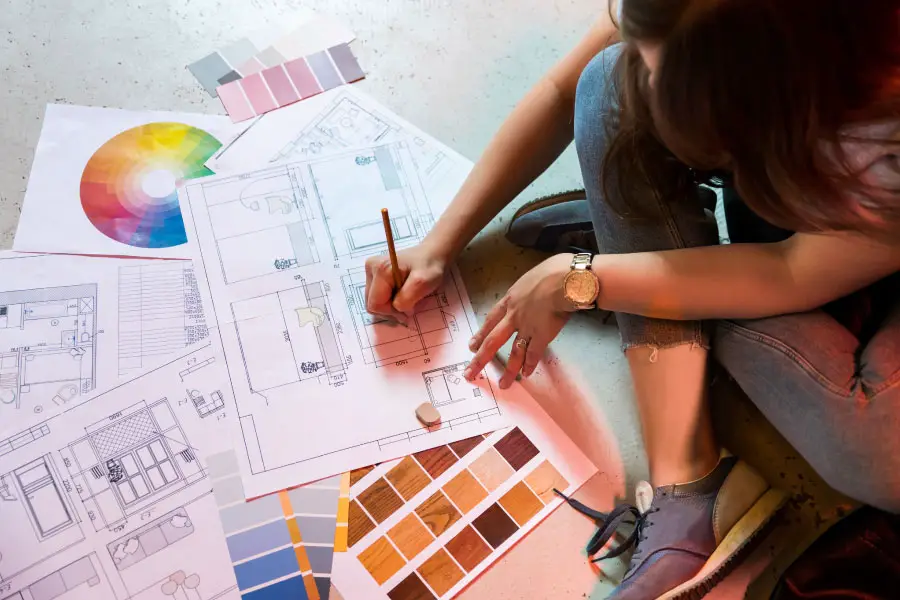Can an Architect Be a Graphic Designer?
Architects and architecture students are designers. Although not well known, architecture students are often learning new ways of expressing their creativity in designs through how they approach problems, create plans, create models, and how they present their works.
Can an architect be a graphic designer? An architect can also find work as a graphic designer. Visual presentation is a major aspect of the practice of architecture, and it crosses over into graphic design. Architects study composition, color theory, aesthetics, and how to use software for their presentations – all useful and essential skills for a graphic designer.
Let’s look at this in a bit more detail now as there are many things to consider when talking about architects and graphic designers.
How architects present their work
In architecture school, students present their work in front of a panel of professors. They always show the plans on a board, a “poster” showing and explaining their design, and a digital presentation.
The usual workflow of an architect/architecture student, when presenting their designs, involves turning their CAD (Computer-aided drawings) into drawings suitable for presentation. Aside from the regular CAD software, architects often employ other methods of enhancing their drawings by using programs such as Adobe Photoshop, Illustrator, Lightroom, etc.
The difference between presentation drawings and architectural drawings is that presentation drawings don’t necessarily have to follow the strict rules of architectural drawings. Architects can digitally alter their drawings in such a way that allows them to convey their ideas to an audience better.
With this, it’s a given that architects/architecture students are required to be proficient in creating graphics, image-editing, composition, choosing colors, graphic design concepts, and many more. The presentation of the project’s design is heavily dependent on how well the architect/architecture student can make an architectural drawing understandable to a client/panel.
A common tip that professors often give is that a good presentation shouldn’t need that much explanation from the student. At a glance, a professor/client should be able to immediately see where you’re coming from and how you arrived at your design.
Going back, here’s the difference between architectural drawings and presentation drawings. They’re both the same drawing; however, through editing, they convey entirely different meanings.
Let’s use a floor plan as an example of this. An architectural drawing would have the following:
- Dimension
- Labels
- Materials
- Call outs
- Finishes
It contains information on how the structure will look. Here’s what a presentation drawing would contain:
- Circulation
- Zoning
- Relationship with outside/other floors.
- Highlights
As an architecture student, it’s important that you master both of these methods of communicating your designs.
How an architect would approach graphic design
Architects and architecture students are used to creating their own graphics, especially for their designs. They constantly have to create and edit photos such as site, materials, vicinity, circulation, etc. to help them translate their research into a more digestible medium and establish the reasoning behind design decisions.
The mindset of an architect, as a graphic designer, is quite different compared to those who solely focus on graphic design, and here’s why.
An architect probably wouldn’t be as good as a dedicated graphic designer in creating new characters, symbols, logos, and things like that. Instead, an architect would be more suited to creating graphics related to people, places, objects, and nature.
Architects are very stiff when it comes to creating things compared to artists. The mindset of an architect is always based on realistic objects, something that can actually exist and be built, while a graphic designer is more abstract and allows their mind to wander through their imagination.
Expect an architect to present things in a more logical fashion.
To better explain this let’s use a graphic for a pencil product as an example.
A graphic designer would probably create a pencil graphic that would be more on the abstract side or integrate pop culture references, etc.
An architect would probably do a cross-section (imagine the pencil cleanly cut in half) showing off the wood, lead, dimensions, etc.
There is nothing wrong between the two because both graphics have their own use.
A big part of the architecture business is presenting designs that would convince clients to approve an architect’s proposal. Architects know how to balance between appealing to a person’s logic (costs and efficiency) and a person’s emotions (through design).

Why architects should also focus on learning graphic design
Simply put, for all of your client presentations, you will be using a digital presentation and presentation boards.
*For those with no background in architecture or are new to architecture, drafted plans are used as legal documents. They are the thing that engineers, foremen, plumbers, and electricians will be looking at.
It goes without saying that the quality and effectiveness of your presentation, in communicating and explaining your ideas, is only limited by your imagination and how well you can use the software.
This cannot be stressed enough. It goes to the point where architecture firms hire software engineers to create customized software to meet their needs.
For architects/architecture students, here are the practical applications, applications aside from aesthetics, for investing time into learning graphic design.
- To better communicate your research:
- Show different layers of the buildings through axonometric diagrams.
- Show the vicinity map study by highlighting nearby landmarks/amenities.
- Show how the sun’s path will affect the site.
- To improve your design process.
- To develop your own original and unique style.
- To better communicate your design intent.
- Use graphics in aiding you to explain design decisions.
- Use custom graphics to meet the needs of the project, use graphics specifically created for the project.
- To gain full control on how your presentation will turn out and create a unique display for your design proposal.
Architecture Career Path
A common misconception is that the field of Architecture is solely focused on design and drawing plans. Since architecture covers such a wide variety of subjects, it’s not uncommon to find architecture graduates who focus and specialize on certain aspects that they perform well in.
Here is a quick rundown of possible career paths within the architectural field.
- Heritage Conservation
Focuses solely on the preservation and rehabilitation of buildings with cultural or historical significance.
- BIM Specialization
Specializes in using Building Information Modeling software, it’s uncommon for some architects to hire a specialist to have their plans and designs translated into digital models and renderings.
- Interior Design
Architects have a background in anthropometrics (the study of the measurements and proportion of the human body), circulation, planning, and design.
- Urban planning and design
Architects are also capable of designing cities, towns, and local neighborhoods.
- Research
All architectural projects require research before any design can be made. Architectural firms usually have a team to look into and compile the necessary information needed to make design decisions.
- Consultant
Large-scale companies and manufacturers can turn to architects and engineers to find ways to either improve efficiency, reduce spending, and reduce environmental impact.
Conclusion
An architect’s job is to solve problems with creative solutions that are visually appealing. In recent years, the digital platform has become the forefront of how architects go about creating and presenting. Learning the software for architecture, CAD(Computer-aided Design) is a staple in the curriculum for architecture schools.
However, although architecture software is fantastic for creating outputs such as drawings and models, they lack the necessary tools for these drawings and models to be easily understood and explained to an audience. This is where architects/architecture students are required to learn how to use photo-editing software to suit their needs.







